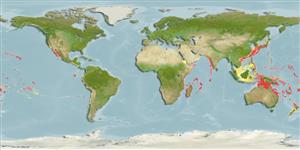Environment: milieu / climate zone / depth range / distribution range
Ecología
marino asociado a arrecife. Tropical
Western Pacific: Japan to Australia and the Kermadec Islands. Recently reported from Tonga (Ref. 53797).
Tamaño / Peso / Age
Maturity: Lm ? range ? - ? cm
Max length : 5.0 cm TL macho / no sexado; (Ref. 2334)
Radios blandos dorsales (total): 12-43; Radios blandos anales: 22 - 40. Body fully scale. At least some of the dorsal saddles reaching a distinct lateral band. Combined number of soft rays in dorsal and anal fins usually 49 to 55 (Ref 12874).
A cryptic species that occurs on sandy or gravel bottoms. Pointed snout is used for burrowing; eyes directed upwards for sighting prey. Found from shallow tide pools to at least 150 m (Ref. 2334). Eyes move independently and possess a refractive cornea, a convexiclivate fovea and a non-spherical lens (Ref. 50869). Neither cleitheral spine gland nor anterolateral glandural goove with gland is present (Ref. 57406).
Life cycle and mating behavior
Madurez | Reproducción | Puesta | Huevos | Fecundidad | Larva
Randall, J.E., G.R. Allen and R.C. Steene, 1990. Fishes of the Great Barrier Reef and Coral Sea. University of Hawaii Press, Honolulu, Hawaii. 506 p. (Ref. 2334)
IUCN Red List Status (Ref. 130435)
Threat to humans
Harmless
Human uses
Más información
Nombres comunesSinónimosMetabolismoDespredadoresEcotoxicologíaReproducciónMadurezPuestaAgregación para la puestaFecundidadHuevosEgg development
ReferenciasAcuiculturaPerfil de acuiculturaRazasGenéticaElectrophoresesheritabilidadEnfermedadesProcesamientoNutrientsMass conversion
ColaboradoresImágenesStamps, Coins Misc.SonidosCiguateraVelocidadTipo de nataciónSuperficie branquialOtolitosCerebrosVisión
Herramientas
Special reports
Download XML
Fuentes de Internet
Estimates based on models
Preferred temperature (Ref.
123201): 18.2 - 28.8, mean 27 °C (based on 664 cells).
Phylogenetic diversity index (Ref.
82804): PD
50 = 0.5156 [Uniqueness, from 0.5 = low to 2.0 = high].
Bayesian length-weight: a=0.00389 (0.00180 - 0.00842), b=3.12 (2.94 - 3.30), in cm total length, based on all LWR estimates for this body shape (Ref.
93245).
Nivel trófico (Ref.
69278): 3.0 ±0.00 se; based on food items.
Fishing Vulnerability (Ref.
59153): Low vulnerability (10 of 100).
Nutrients (Ref.
124155): Calcium = 196 [92, 406] mg/100g; Iron = 0.953 [0.517, 1.781] mg/100g; Protein = 17.8 [16.5, 19.0] %; Omega3 = 0.0915 [, ] g/100g; Selenium = 16.7 [6.6, 42.5] μg/100g; VitaminA = 380 [100, 1,505] μg/100g; Zinc = 2.72 [1.66, 4.19] mg/100g (wet weight);
